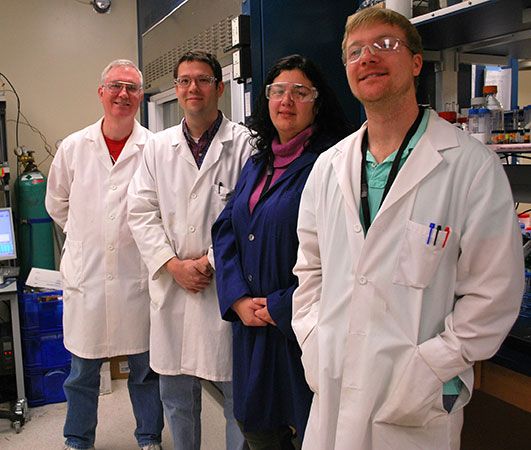U.S. Army Recognizes Institute's Sweeping Advances in Biotechnology with $48 Million Contract Renewal

Army Research Lab Biotechnology team members David Mackie (left), James Sumner, Dimitra Stratis-Cullum and ICB-Caltech post doctoral researcher Matthew Coppock (right) work together with academic counterparts in Jim Heath's Caltech laboratory to shape basic research into projects that could have useful applications. Image courtesy of U.S. Army Research Laboratory.
U.S. Army experts along with leading university professors and industry partners have been collaborating over the last decade to explore biological systems that have the potential to drive sweeping bio-technological advances for U.S. Soldiers.
The research is led by UCSB at the Institute for Collaborative Biotechnologies (ICB), a University Affiliated Research Center (UARC), in collaboration with the Massachusetts Institute of Technology (MIT) and the California Institute of Technology (Caltech).
As part of the contract renewal, some 60 world-class investigators form teams to explore research in the areas of systems and synthetic biology, control and dynamical systems, photonic and electronic materials, cellular structural materials, biotechnology tools, and cognitive neuroscience.
The ICB contract with the U.S. Army Research Laboratory (ARL) and Army Research Office (ARO), was extended in December 2013, providing an additional $48 million over three years to study high performance biological systems and the transition of these to engineering systems of benefit to Soldiers.
Robert Kokoska from ARO's Physical Sciences Directorate, manages the relationship between the Army and the ICB. Kokaska said, "Looking ahead, the value first and foremost will be a more comprehensive integration between the ICB and partners in Army and industry. The institute researchers have unique insight about bio-inspired technology. Likewise, the Army has complementary capabilities and understanding of the military operating environment that the academic researchers could leverage. For example, in 2014, the ICB will start to look toward integrating some of their materials research into ARL's cross-directorate enterprise in the multiscale modeling of materials.”
“The hallmark of UARC’s is the collaboration between the Army scientists and engineers, directly with university researchers throughout the research process,” said Kokoska. “From the program's inception, we've been able to gain a basic understanding of a number of biological systems to the extent that bio-inspired materials can be synthesized and studied. For example, the characteristics of a moth's eye are being mimicked toward the development of anti-reflective coatings. With an understanding of the physics underlying reverse adhesion of the gecko foot, we could create fascinating robotic technology. Biological systems offer endless possibilities for the military to model synthetic materials."
Kokoska continued, “The ICB also includes a channel to transition an idea from basic discovery toward technologies that address specific Army needs, referred to as 6.2 research. The projects apply science to more specific military needs through collaborative efforts involving research contributions from academic, Army and industrial partners. The Army/academic/industry partnership at ICB is a win-win-win proposition.”
"We're looking forward to a number of technologies from the ICB 6.2 (Applied Research) program to further mature down the pipeline," Kokoska said. "We expect further advances in power and energy; battery and fuel cell research; and field-expedient sensors. ICB teams have already developed revolutionary technological innovations in bio-inspired materials and energy, biomolecular sensors, bio-inspired network science and biotechnological tools. Several scientists at ARL are now working with ICB counterparts on projects that have the potential for future Army applications.”
Research Chemist James Sumner was first introduced to the ICB at its inception and has collaborated in both the 6.1 (Basic Research) and 6.2 programs. Recently named the ICB's associate program manager, Sumner's first ICB collaboration was an example of the synergy that is possible with the program.
Sumner met Professor Gui Bazan years ago at an ICB Army-Industry Collaboration Conference. Bazan was giving a keynote address explaining a new class of molecules designed to fluorescently label cell membranes. While Bazan and Sumner had different backgrounds, they discovered their research goals could be reached through mutual collaboration. This interaction has led to multiple peer-reviewed journal publications and a patent on enhanced electron transfer through cell membranes.
“These advances have shown how it is feasible to enhance and control microbial metabolism for applications such as microbial fuel cells and waste mitigation,” Sumner explained. "The professors we interact with in the ICB are world-renowned experts for their fields of specialty. To gain access to the knowledge that they possess and to be able to collaborate with them to provide new technologies for our Soldiers is a great feeling," he said.
UARC’s like ICB, conduct basic and applied research to ultimately develop technology. The university, considered at the forefront of research and innovation, provides dedicated facilities and share space with Army and industry partners. The emphasis is to conduct research where breakthroughs are likely to enable revolutionary capabilities for the U.S Soldier.
